Cold hardy european plums
Fresh european plums are not something I have had a chance to try. But I know a number of folks who share my tastes and love them.
It is one of the few tree fruits that I can grow and have not tried.
So I am thinking of tacking one on to an order with cummins this spring
I think the only ones they offer that would be dependably cold hardy for me are opal, mt royal, and possibly green gage.
Unfortunately the opal is on pumiselect and I don't think I want a dwarfing rootstock(...can you plant plums deep to get self rooting?)
And I believe green gage is only partially self fertile?
Any other suggestions, or relevant info in terms of cultural issues to be aware?
Comments (41)
eboone_gw
10 years agoI can only give some answers - I have a Green Gage about 8-9 yrs old, last year got abt 2 dozen fruit after a tree full of flowers, so partially self fertile may be right. I am on edge of zone 6a-5. Tree is too tall on Myrobolan (>20 ft tall), I'm going to do some corrective shortening soon and try to maintain it there. It is one of the most delicious fruit I've ever had.
I have ordered an Opal from Cummins this year to try to extend my season earlier and get better polllination
No experience with the planting deeper question but it is supposed to work with apples and pears.
The green gage has had some black knot requiring pruning it out but I am next to a woods with wild black cherries and a few feral sweet cherries within 60-70 yards-they host it.Good luck with the plums!
Ed
fruitmaven_wiz5
10 years agoI bought Mt Royal from St. Lawrence Nursery (zone 3/4, in NY), and they instructed me to plant it deep so it grows on it's own root. (It is a natural dwarf.) It is very healthy and happy, this will be it's third spring in my slightly alkaline, compacted clay soil. It's about 4' tall now. St. Lawrence has a very nice selection of plums, including several European types.
My Mt. Royal hasn't fruited yet, but I bought some at the farmers market and am very pleased with the flavor.
No disease issues yet, though all the wild plums around have black knot, so I'm sure I'll see it someday.
Related Professionals
New Mexico Landscape Architects & Landscape Designers · Panama City Landscape Architects & Landscape Designers · Southfield Landscape Architects & Landscape Designers · Wheeling Landscape Architects & Landscape Designers · Zion Landscape Architects & Landscape Designers · San Juan Landscape Architects & Landscape Designers · Arlington Landscape Contractors · Bridgeport Landscape Contractors · El Sobrante Landscape Contractors · Oviedo Landscape Contractors · Spring Landscape Contractors · Tavares Landscape Contractors · Watertown Landscape Contractors · Reisterstown Landscape Contractors · Merrifield Landscape Contractorswindfall_rob
Original Author10 years agoYes, black knot has been a concern. No infected trees in the immediate vicinity, but I see plenty of it in the woods and along the road.
Konrad___far_north
10 years agoStanley and Italian might work also, ripening out could be a problem, I had Stanley and it ripened out, but now I lost that top graft. Another one is a small yellow plum, Mirabelle de Nancy, and Damson.
fruitmaven,
not sure why deep planting the Mt. Royal, yes, naturally dwarfing on it's own root, do you want a small tree?
Some trees here are grown on it's own root but our harsh climate makes it a very very slow grower, grafted to a vigorous rootstock can make it a faster growing tree.Some pictures in link
Here is a link that might be useful: Lets talk about Plum
marknmt
10 years agoItalian prunes do well here and are convenient in size on their own (sucker) roots. Take several years to bear, easy to prune, beautiful to see, ripen gradually in September. One of my all time favorite fruits.
plumhillfarm
10 years agoHello, you may want to stay away from the later ripening plums like Stanley, Valor, Empress or Italian as there have been years when they did not ripen here due to cool weather in Sept, and you are cooler than I am.
Mt Royal is a good choice, hardy, mid season. Make sure you thin it as it overbears. Think about Ersinger (early), Long John (mid-late, does well here), Early Laxton (early orange-yellow spotted), Seneca (mid, large and good). We also fruit Rosey Gage (but the trees are tiny), Oullins, Opal and a bunch of older varieties you cannot get from nurseries.
The Mirabelles need heat to ripen, so if you want a Mirabelle I would suggest you get a rootstock and pick up an American Mirabelle scion (much earlier than Nancy or De-Metz) when you come over for the peach scions
All get Black Knot and Brown rot
Raintree has a good selection if you like their rootstock.
If you are going to plant deep, insure your raised beds are high enough to keep the roots from suffocating before more can grow out of the trunk, it can really set them back or kill them.
We used to have a Green Gage, but even with spraying it was a brown rot magnet and cracks like crazy, hard to get a decent amount of fruit off of it in this humid climate.
Eric
mrsg47
10 years agoHi, I have most of the above mentioned European plums and I live in zone 7. This past summer was not very warm and it took until October for my Italian plums to ripen. I also have a Reine Claude de Bavay green gage-type plum and three Mirabelles. They all seem to need a long season. Mrs. G
olpea
10 years agoRob,
Quite a few years ago I wanted to try plums and started mostly with Japanese type. I found out they bloom too early for my climate and switched to Euro plums.
The Euros have just started fruiting in the last few years. So far, I'm very pleased with the Euros. They are mostly freestone and the skin isn't quite as tart.
I've not tried Opal or Mt. Royal, but do have Green Gage. It is indeed a very good quality plum. It does ripen later in the season, so don't know if that will be a problem for your locale.
I don't have black knot on my plums but generally spray once early with chlorothalonil. I also tank mix a fungicide for scab, when spraying for plum curc., which probably also helps to control black knot.
As Plumhill indicated, I think you'd be fine to bury the graft below grade (for winter protection) as long as you had decent drainage, or mounds.
I've buried all my plum grafts below grade. They've done fine, but I never looked to see if the plum scion portion has rooted out (need to do that).
windfall_rob
Original Author10 years agoThanks all this is helpful info.
Black knot and brown rot are among my biggest concerns...especially as I continue to attempt organic methods.
I know the euro plums are prone to both, but have gathered that some varieties are especially so. As Eric referenced for green gage(brown rot) and I know I have seen harvest man reference some black knot "problem child" although I can't remember which at the momentEric, I was hoping you would chime in as your experience regionally is particularly useful. And it has me thinking about just grafting in varieties from you place...either in addition to or in place of the peach I was going to come cut this summer. Thanks again.
I had been leaning toward opal, people speak well of it, very hardy and fully self fertile. my question regarding planting deep was in an interest of self rooting to add vigor to the tree (since they only have it on pumiselect)
Now I am thinking my royal may be a good place to start.I suppose what I really should do is get into the Burlington farmers market this summer (whereeric/plum hill sells) and try a bunch of these guys before committing.....
alan haigh
10 years agoHere Mt. Royal is mediocre compared to other varieties like Valor and Castleton, at least if you are most into fresh eating. However, it is the most cold hardy of productive varieties I grow and if it's all you can grow you will love it. It is in comparison that it suffers.
There is no chemical solution for black knot so being organic won't be an issue there- you just have to cut it out. Methely is the typhoid Mary of whom you speak.
If brown rot becomes an issue, maybe you will get over your need to avoid useful synthetic chemicals in fruit production- or you can try sulfur.
I would think that up there brown rot and BK would be less a problem given your greater quantity of low humidity days. Love that Canadian air.
You can always start with Mt. Royal and experiment with grafts.
mamuang_gw
10 years agoI have a chance to pick up either Long John or Valor. What would you recommend and why please? Thanks.
I have already ordered Castleton for this spring.
olpea
10 years ago"There is no chemical solution for black knot so being organic won't be an issue there- you just have to cut it out."
While it's true black knot must be cut out, chemical controls do help prevent the disease (or further spread of it) as I'm sure Hman is aware.
Either way I understand Rob you aren't interested in chemical controls. If you do decide you need a preventative, copper is supposed to be somewhat efficacious as an organic choice.
Plumhill,
Thanks for that chart. Very informative. Have you seen any problems of precocity in Long John? Hman has mentioned a significant delay of fruiting in the Long John trees he's managed. Have you seen that in your orchard?
mamuang_gw
10 years agoPlumhill,
Thank you very much for the chart.
Plum is my favorite fruit but to me, it seems to be the most problematic fruit tree!!!
mrsg47
10 years agoWhat I have also found is that my European plums have taken a good six years to produce a good crop. There is not much precocity with my Euros. They grow sturdy and strong, but fruit production is very slow. Mrs. G
mamuang_gw
10 years agoMrs. G,
Do you have much problem with black knot on all your plums, please? Which variety is the most resistant one for you?
Your area is not far from mine. What grows well in your area has a good chance to do well in mine. Thanks.
fruitmaven_wiz5
10 years agoKonrad, I always need small trees. I'm on a suburban lot, 50 ft wide and 100 ft long, with a 30'x30' house in the middle. I like to prune, but dwarf trees are necessary for me.
olpea
10 years ago"What I have also found is that my European plums have taken a good six years to produce a good crop. There is not much precocity with my Euros."
Mrs. G,
My Euros are a little slower too. They take 3-4 years to start producing. Hman has mentioned Long John can take 10 years to start producing.
mrsg47
10 years agoMamuang, I have no Black Knot on any of my plums. One very humid summer, I pruned off one branch of a Montmorency cherry that had Black Knot. Not one plum in seven years has ever had Black Knot.
Olpea, it is amazing that Euro plums to take so long to produce. In year three I had blossoms but all of the fruit dropped. In year four I had eight plums. Last summer I finally had in the hundreds from one tree. Yikes! Mrs. G
mamuang_gw
10 years agoThanks for the response, Mrs. G. Which one is your favorite, please?
Olpea - thanks for reminding me of how long it takes for Long John to produce. 10 years is too long for me esp. I don't have much space to spare.
alan haigh
10 years agoLong John just hasn't proven a reliable producer for me- perhaps it is not pollinated by Valor or Castleton, the two varieties I'm most likely to put it next to. I will get tremendous floral display from its ample pendulous small wood, but most of the fruit drops when it is still tiny.
Rating plum flavor by numbers without a description of qualities is very helpful but only gets you so far. I find that the flesh of many types of prune plums is similar if fruit holds onto the tree long enough for the flesh to turn amber.
I don't think most people could differentiate between the pulp of Castleton, Valor, Seneca or Empress if it was compared at similar ripeness.
I think Castleton is probably rated lower on this chart because it is a smaller plum and the extra skin affects the eating experience. Stanley drops from the tree before it gets to peak ripeness. Mt Royal is more astringent, I think, and that's what takes from its flavor.
Some plums are less tasty because of higher astringency, which tends to make the preserves more distinctive. If you want preserves, there is no better plum for this purpose that I've tried (and I haven't grown all those on the Plumhill list) then the Damson plum.
Damson preserves are tangier and a more beautiful color (more reddish purple than brownish purple) than preserves made with sweeter, less astringent plums. It has proven to be a very reliable and heavy producer for us that we don't bother to thin. It looks ripe at least a month before it achieves highest sweetness and softens a bit.
plumhillfarm
10 years agoThe Long Johns I have were normal time into coming into production, 4 or so years are extremely productive with huge good tasting freestone fruit (but I have a lot of different pollinators). Every year since Harvestman first posted his issue with long John I think of him while picking the fruit. The trees are weepers and fruit heavily on the thin pendulant wood so don't cut it all off (the trees like to be ugly, putting up long vertical shoots which them bend down, not what you see in the pruning books).
Castleton got a lower rating because it is so hard to tell when they are ripe, they are still hard (they are not very good when soft), ripen somewhat unevenly so you always get some not quite ripe fruit in the pick. When perfectly ripe they are quite good, very sweet.
Mt Royal does not drop (in fact it is hard to pick when fully ripe without breaking some stems off) so can be left on until fully ripe but you have to taste them to tell when that is.
In 2011 we have an explosion of black knot due to 12 weeks or so of record rains and flooding. I cut out hundreds of knots, now 2 years later it is mostly cleaned up so cutting out does work.
I find plums are easier to grow than apples, peaches or cherries, take less spray (apples are the worst) and are tolerant of soil and climatic conditions which would kill other fruit trees. The only easier one I can think of are pears. Brown rot was the only real issue, but now we have SWD and Stink bugs to deal with which I will start another post on.
mamuang_gw
10 years agoThank you H-man and Plumhill for your input. It looks like there are a few variables that make the same fruit tree responds differently in different locations. It's always good to know how others experience.
In my yard, ranking from easiest to more difficult are apple, pear (Asian), pear (Euro), cherries (sour), cherries (sweet) and peach.
I only have Satsuma and Shiro plum. One Satsuma suffered a mysterious death (graft incompatible?). The other got canker badly on a few areas of its small trunk. I may need to remove the whole tree. So far, even J. plum does not look too good.
olpea
10 years agoYes, as Mamuang said, thanks for the input Hman and Plumhill.
Plumhill, I hear what you are saying some plums aren't very good soft. For most plums I prefer to pick them slightly (emphasize slightly) firm. They get too mushy (yucky) for my tastes if left on the tree too long. Interestingly, I don't mind peaches really soft.
It does sound like Long John may be picky about pollination. My Euro plums are more unpredictable at the house (where I've only got 4 varieties left). Sometimes a tree will have a nice bloom with hardly any fruit, other times it will be loaded.
After this spring, I should have about 15 varieties out at the farm. Perhaps pollination will be more consistent there.
alan haigh
10 years agoPlum, what you find to be true of Castleton is exactly my experience with Valor, only I don't mind feeling my way as I pick in exchange for a very long harvest season. I harvest Valor for almost two months here- Sept-Oct. and I do treasure that luscious fruit for fresh eating.
Castleton won my heart by being the most reliable producer of high quality prune plums of any I grow. Victoria, Damson and possibly Mt. Royal are equal in this regard, but not nearly so good for fresh eating.
In Z4 your pest pressure must be completely different. Here E-plums are particularly attractive to plum curculio and often suffer from brown rot. J plums are easier here, but I've heard of the opposite being true in the mid-west.
Stanley seem less susceptible to disease and insects compared to other E plums.
olpea
10 years ago" Here E-plums are particularly attractive to plum curculio and often suffer from brown rot. J plums are easier here, but I've heard of the opposite being true in the mid-west."
Peaches are the easiest to grow in my locale (if grown in a raised planting). Euro plums grow much slower (so fill in their space slower) take an extra year to start bearing, and are harder to get established. Grasshoppers love to defoliate young Euro plum trees (as do deer).
Peaches grow like weeds and the foliage is bullet proof (as far as deer and leaf eating insects). The fuzz on the fruit also makes it less susc. to insects.
Japanese type plums were easier to grow than Euros for me (but not as easy as peaches) mainly because they have more vigor. Unfortunately they bloom too early here.
Just goes to show how different fruit growing can be in different regions.
mrsg47
10 years agoMamuang, my favorite is still the Italian Prune Plum. It has so many uses. You can eat them fresh off of the tree, at the very end of Sept. to early Oct.; dry them, make Pruneaux, jam or tarts and cakes. Love them all. My second would be the Mirabelles then lastly (ridiculous to say this really because they are all fabulous) is the Green Bavay which is a taste unto itself. The Mirabelles are quite 'perfumey' and exotic. They make the best tart. Mrs. G
alan haigh
10 years agoI've yet to taste a Mirabelle. I may never as I've got so many different plums to deal with already.
Italian tends to be a light cropper in the northeast (Cornell agrees, see link), and the fruit are pretty small, especially considering their light cropping, but it is a nice tasting fruit with a special flavor. It seems to suffer less from black knot than most plums so that is a pretty strong positive in itself here.
The man who posted about the difficulty in growing J.plums compared to E plums lived near Chicago as I recall. He used to be a frequent poster here who grew a lot of Macintosh apples for cider.
The link should bring you to a page with descriptions of a wide range of plums.
Here is a link that might be useful: Cornell plum rating
alan haigh
10 years agoIt is interesting how many of the Cornell descriptions conflict with my own experience. Things like Damson having green flesh when it actually can ripen to an amber color here or that Methely has an unpleasant bitterness near its skin rendering it useless for commercial production. It's not a bitterness I've ever detected.
They say Castleton is often picked before it is ripe, which coincides with Plum's experience.
I guess the take away is that no advice is universal and given the variables of site, growing techniques and palate you must take it all with a grain of salt.
mamuang_gw
10 years agoMrs. G. Thank you for your input. I likes fresh eating fruit. I don't cook with any fruit. Cooking is not my forte (to put it positively). I love how your describe the taste of the fruit, very enticing. You should write descriptions for those catalogs.
H-man,
I enjoy hearing comments/suggestions from others. I take them into considerations. In the end, it's I who decide what to do with those suggestions.Always appreciate everyone's input, contradictory or not.
mamuang_gw
10 years agoPlumhill,
I re-read your chart. Empress got the highest marks in all 3 catagories. How come no one talk about it?
Are there any downside on Empress that you could share with us, please? Thank you.
Konrad___far_north
10 years agoplumhillfarm 4b Vermont,
thank you for posting this list!
Question, ...how come you rate Mt. Royal as zone 5?
This one supposed to be one of the hardiest Euro plum, rated as zone 4.
Are you saying that all zone 4 plums in your list are hardier then your Mt. Royal?plumhillfarm
10 years agoKonrad, the hardiness numbers are not zone numbers but relative hardiness. 5 is the highest (as in had the least amount of bud loss), 1 the lowest. I cannot judge zones as I only have experience in 1 of them. They are mostly bud hardiness, as we have not had a severe winter (Eric
Eric
lavender_lass
10 years agoI have Italian plums and they are wonderful! They came with our farmhouse and they are very hardy. Great for baking and never have any frost trouble. Very pretty when they bloom, too!
Here's one that about 15' tall (we have three) and the ice never bothers it. {{gwi:59144}}From Lavender's Garden
Here are the other two in the summer...the one on the right is at least 20' tall. The HUGE poplar next to it makes it seem smaller :) {{gwi:59145}}From Lavender's Garden
charina
10 years agoEric,
How did you obtain your Great Yellow? I'm not finding any information for sources on the web. I'd like to add that to my small collection (Stanley, NY9,Imperial Epineuse, Empress, and Pearl)
I really appreciate the table you posted. One thing that could make it better would be to list relative ripening timing.
While my E plum experience is shallow, I'm not sure I concur with the low marks for Stanley by Eric and Hman. Perhaps it simply favors the hot dry summer climate in UT, but the fruit has been outstanding for me.
plumhillfarm
10 years agoHello, I got Great Yellow from GRIN a long tome ago. I am unsure if it is an Euro or Japanese as it is not obvious. I read somewhere that it is a Luther Burbank introduction from Euro parents, but can not now find the reference. It fruits during the last part of the Shiro harvest and confuses people because they look similar.
We are not saying Stanley's are bad, just that others are better. Have you fruited the Empress or Imperial Epineuse yet? I find they have more flavor than Stanley's.
Konrad___far_north
10 years agoThanks Eric!
>>the hardiness numbers are not zone numbers but relative hardiness. 5 is the highest (as in had the least amount of bud loss), 1 the lowestSo it's the other way around, if I understand correctly, ..the higher the better, do you think all 5 and perhaps 4 would do fine for me,..since Mirabelle de Nancy, [in your list zone 2] I can grow pretty good, some freeze back, fruiting buds seems pretty tough.
What about freeze back, are you getting any?
charina
10 years agoThanks Eric. My empress and imperial epineuse are too young to bear yet, so I don't have a comparision there to refer to.
Gardening_Maestro
10 years agoalan haigh
10 years agoBeautiful fruit, maestro, bravo! I've long felt that plums are the most photogenic fruit in my orchard as well. Such variation in color, size and shape but all so enticing.
Adrian_Lee
9 years agoPlum Hill Farm, do you trade, sell, or ship scion wood? I'm really interested in the Mirabelle varieties and you're the only ones that I've come across on the internet that grows them. I realize Raintree sells the already grafted trees, but I enjoy grafting myself and saving a bit of $$. If you would be willing, would you message me on here? Thanks!
Adrian


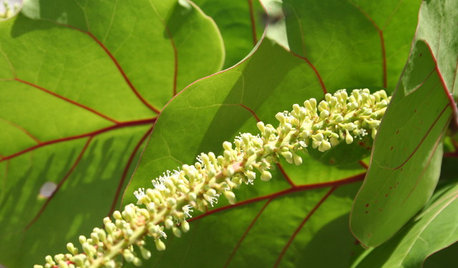
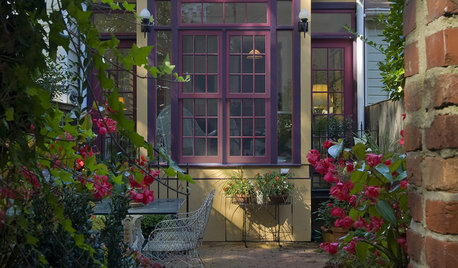


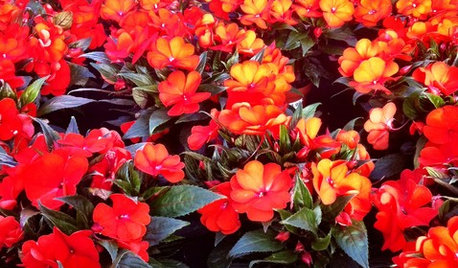


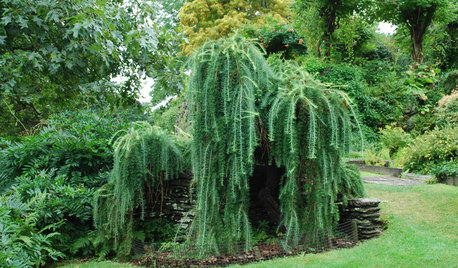






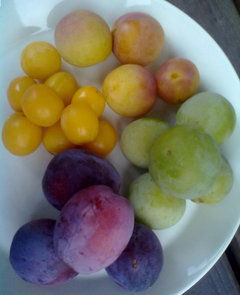



plumhillfarm